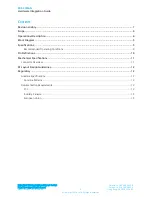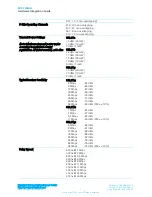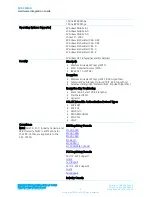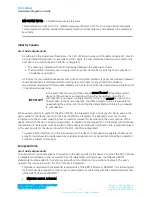
SDC-CF22AG
Hardware Integration Guide
Embedded Wireless Solutions Support Center:
http://ews-support.lairdtech.com
www.lairdtech.com/bluetooth
14
© Copyright 2015 Laird. All Rights Reserved
Americas: +1-800-492-2320
Europe: +44-1628-858-940
Hong Kong: +852 2923 0600
2.
The transmitter module is not co-located with any other transmitter or antenna that is capable of
simultaneous operation.
As long as the two conditions above are met, further
transmitter
testing is typically not required. However,
the OEM integrator is still responsible for testing its end-product for any additional compliance
requirements required with this module installed, such as (but not limited to) digital device emissions and
PC peripheral requirements.
I
MPORTANT
!
In the event that the two conditions above
cannot be met
(for example certain
device configurations or co-location with another transmitter), then the FCC
authorization is no longer considered valid and the FCC ID
cannot
be used on the
final product. In these circumstances, the OEM integrator will be responsible for
re-evaluating the end product (including the transmitter) and obtaining a separate
FCC authorization.
When using Summit’s FCC grant for the SDC-CF22AG, the integrator must include specific information in the
user’s guide for the device into which the SDC-CF22AG is integrated. The integrator must not provide
information to the end user regarding how to install or remove this RF module in the user’s manual of the
device into which the SDC-CF22AG is integrated. The following FCC statements must be added in their
entirety and without modification into a prominent place in the user’s guide for the device into which the
SDC-CF22AG is integrated:
“IMPORTANT NOTE: To comply with FCC RF exposure compliance requirements, the antenna used for this
transmitter must be installed to provide a separation distance of at least 20 cm from all persons and must
not be co-located or operating in conjunction with any other antenna or transmitter.”
Federal Communication Commission Interference Statement
This equipment has been tested and found to comply with the limits for a Class B digital device, pursuant
to Part 15 of the FCC Rules. These limits are designed to provide reasonable protection against harmful
interference in a residential installation. This equipment generates, uses, and can radiate radio frequency
energy and, if not installed and used in accordance with the instructions, may cause harmful interference
to radio communications. However, there is no guarantee that interference will not occur in a particular
installation. If this equipment does cause harmful interference to radio or television reception, which can
be determined by turning the equipment off and on, the user is encouraged to try to correct the
interference by one of the following measures:
1.
Reorient or relocate the receiving antenna.
2.
Increase the separation between the equipment and receiver.
3.
Connect the equipment into an outlet on a circuit different from that to which the receiver is
connected.
4.
Consult the dealer or an experienced radio/TV technician for help.
FCC Caution: Any changes or modifications not expressly approved by the party responsible for
compliance could void the user's authority to operate this equipment.
This device complies with Part 15 of the FCC Rules. Operation is subject to the following two conditions: (1)
This device may not cause harmful interference, and (2) this device must accept any interference received,
including interference that may cause undesired operation.




































